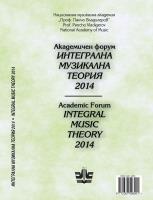Понятието „звукоред“, съотнесено към древноруската теория
The Flexible Term „Scale“ in Reference to the Old Russian Theory
Author(s): Vesela BoyadjievaSubject(s): Philosophy, Social Sciences, Education, Fine Arts / Performing Arts, Music, Aesthetics
Published by: Издателство НМА „Проф. Панчо Владигеров”
Summary/Abstract: The study is focused on the dynamic processes taking place in the Orthodox singing practice over the 16th and the mid 17th c. That was the time when znamenniy raspev co-existed alongside with its later monophonic variants, as well as the Old Russian polyphony. In modern medievalism this sum of chants is expressed by the collective term mnogorazpevnost (multi-voice chanting). The term scale does not exist in Old Russian theory. The formation of the scale notion is related to the understanding of the tone as a separate unit. A brief historical overview is presented, based on the periods concerning the formation of the notion of point, respectively, of a music straight line. The short-range melody is closely connected with the Russian understanding of a musical system consisting of four identical trichords (soglasie). The study includes a tessitura-timbre argumentation for the formation of the notion of scale. This clarification supports the idea of the ascetic nature of this type of singing. Singers’ interchangeability when singing any of the parts in the multi-voice chants is related to the conceptual understanding of singing as an act of obedience. Despite the fact that the term obihodny zvukoryad (obihodny scale) was established in the 17th c., Western European theorists make interpretations based on negative comparison. Scale is at the same time viewed as trichord (soglasie), tetrachord and hexachord.
Journal: Академичен форум »Интегрална музикална теория«
- Issue Year: 2015
- Issue No: 1
- Page Range: 21-31
- Page Count: 11
- Language: Bulgarian

